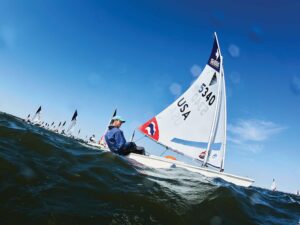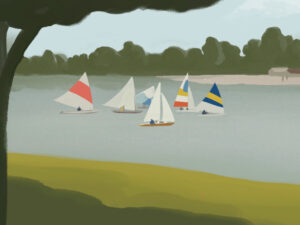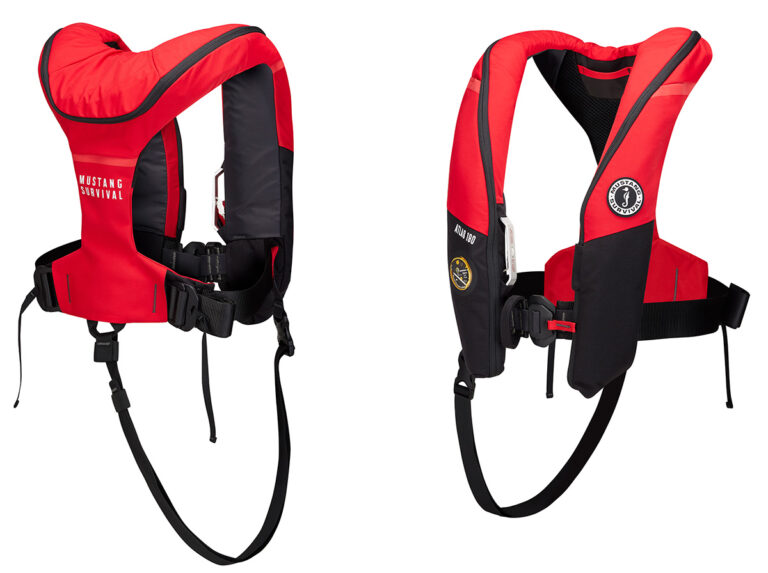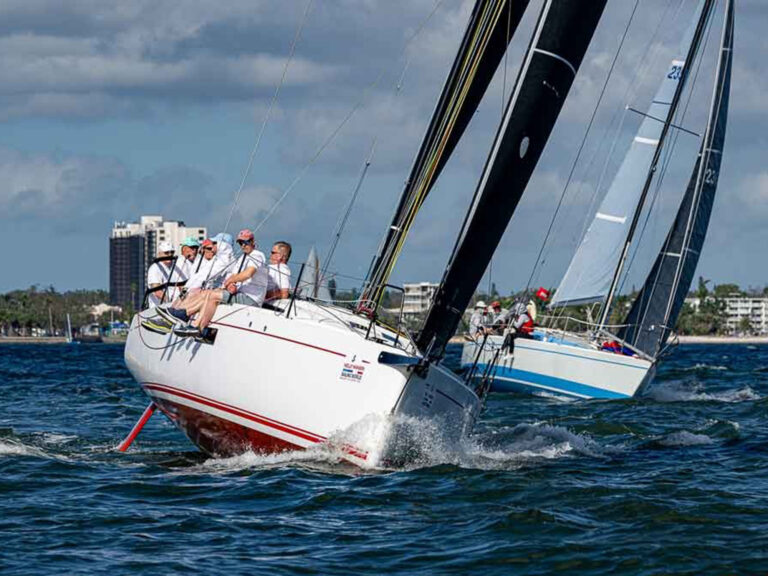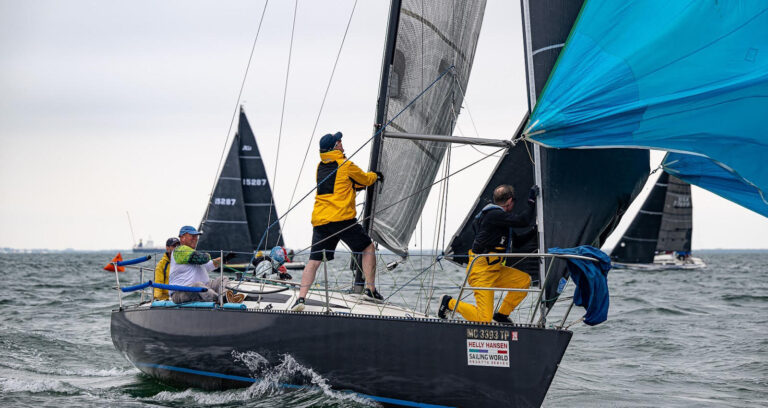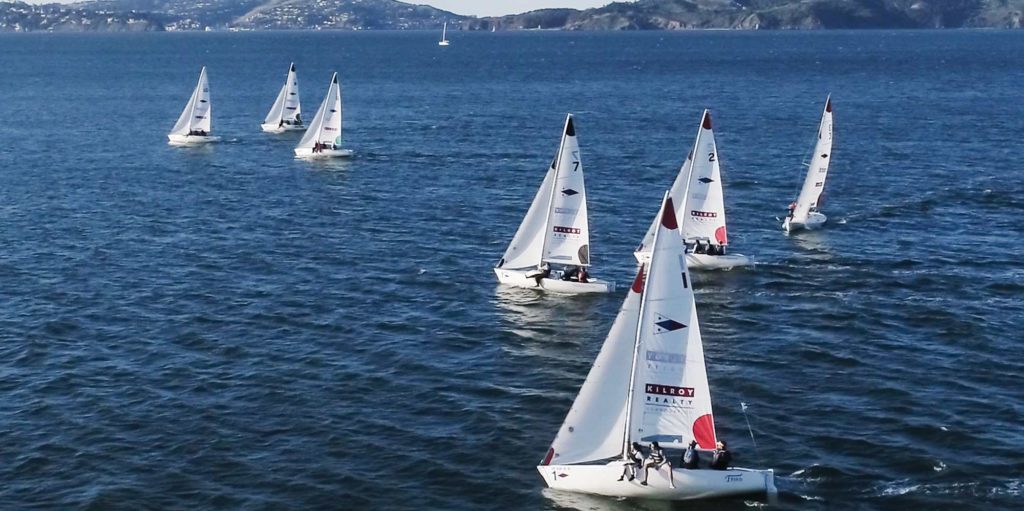
Of all the various Lipton Cup races at ports around the United States, the one that up and died was the one in San Francisco. The old format wasn’t packing them in. That format — enter one boat per club, meet on the water for one handicap-scored race, wave across the water and go home — well, that had come down to one club that, for two years in a row, sent a boat around the course alone, leaving the crew frustrated and thinking no, no, no to a rinse and repeat.
Then, in 2018, the Lipton Cup on San Francisco Bay saw nine clubs enter for three days of competition and festivities, with different crews each day. What changed? Everything. Key No. 1 was to embrace the crisis. Key No. 2 was recognizing an opportunity in a club-owned fleet of matched boats available for charter. Key No. 3 was a format that brought people together (open windward/racing, a cross-bay race for women skippers and a cross-bay race for skippers age 60-plus), as if there might be truth to what sailors are always saying: “It’s about the people.”
Ten years ago, when St. Francis YC purchased its fleet of J/22s, the arguments in favor focused on developing team racing and match racing and holding on to young adult members not ready to buy a boat. Rescuing a Lipton Cup event for the Pacific InterClub Yacht Association wasn’t on the radar, much less enabling a three-day regional regatta that drew all the “big boy” outfits who then lost out to tiny Inverness YC, on the shores of lovely Tomales Bay. It turns out, however, that St. Francis’ club fleet has delivered everything envisioned, and more, and added a popular platform for youth sailing. Now, there is one big problem. The boats are over-subscribed. Demand exceeds supply.
I have friends who claim that club-owned fleets are the future, or they’re critical to any vital future. There also are plenty of cases where club-owned boats are the now. Many clubs have established fleets, especially on the Atlantic seaboard. Indian Harbor YC has its Ideal 18s. Boothbay Harbor has J/22s and BH One Designs, and of course there is New York at Harbour Court, with its Sonars and, soon, spanking-new IC37s that will be out of the reach of most and too much boat for most purposes anyway. In other climes, Southern YC has its Flying Scots, and Long Beach YC the Catalina 37s. The list goes on.
Along with its Congressional Cup-led innovations, such as on-course umpiring, Long Beach YC has leveraged its fleet to earn a position on the world stage of match racing. However, when I sat down with Kiwi expat and Long Beach local Scott Dickson, the first reality that came rolling across the table was the need for something very different. That is why this is worth talking about.
I have friends who claim that club-owned fleets are the future, or they’re critical to any vital future. There also are plenty of cases where club-owned boats are the now.
“We heard about a sailing school in Marina del Rey that wanted to unload some Solings,” Dickson says. “I proposed to the club that we get those boats, and I would get them sailing. For a $500 donation to the school, we wound up with three Solings and an Etchells, not that we wanted the Etchells. The next step was to get them standardized, or standardized enough. Mainsheet controls are a priority, but it doesn’t matter if two boats have different jib halyard arrangements. And being from an Olympic class, the Solings were over-equipped for basic sailing. We got rid of as much hardware as we could. We went to loose-footed mains, and we canned the spinnakers.”
And that was only the beginning. The Etchells went away, the Soling count is now up to seven and the club didn’t exactly overpay for any of them. “Solings look good on the water,” Dickson says. “They’re pretty. They sail well. During the summer, ours get used five or six days a week. Every boat has its own working sails — some of those sails are older than I am — and they live on the boat. A member can sign a boat out and be sailing in minutes. Having this fleet boosts our adult learn-to-sail program, and it’s good for membership. We have people who were looking at different clubs and looking at sailing lessons, and the Solings are a draw. We also get adults whose kids are in our junior program, and they’re mystified by the lingo their offspring bring home, so they come around to find out what all the noise is about. There’s also a STEM program for high-schoolers, and they bus kids in for that.”
Beyond the daily volume of sailing, Long Beach has Wednesday-night racing, and therein lies a streak of religion. For its Wednesday races, the club provides matched, heavy-duty sails that otherwise live under lock and key. A set of small asymmetric spinnakers just might be in the offing for 2019, and it’s worth noting that Wednesdays run a two-race schedule. The first race caters to entry-level skippers and crews; the second is there so the hotshots can have a go at their friends and “friends.”
At first, our J/22s were trailer queens, preserved as precious commodities for the next round of match racing or team racing. It takes a lot of work to keep the boats up to snuff, but they’re not doing anyone any good while they’re dry.
Given his Kiwi origins, Dickson is familiar with the Royal New Zealand Yacht Squadron, where, as he says, “the junior boats and the training boats are all lined up,” looking new and shiny, with big sponsor logos on the topsides and sails. For American sailors, all you can say is that’s a different world. At a time when British builder RS Sailing has rolled out its RS 21, imagined and engineered as a platform for institutional fleets, many clubs and community sailing centers will look longingly in that direction, but only a few can take the financial plunge.
As a longtime member of St. Francis YC, I well remember that it took years to persuade our board to take on the challenges and responsibilities that go with owning and maintaining the J/22s. The usage has evolved too, in ways that mirror the different value propositions of Long Beach YC’s Catalina 37s versus its “beater” Solings. At first, our J/22s were trailer queens, preserved as precious commodities for the next round of match racing or team racing. Bit by bit, we nibbled at that until, today, they’re used a lot. They’re hybrids, if you will, still preserved as a matched set but available for evening races, weekend races and training exercises as well as specialty events. They’re also popular in the springtime when we give our kids a break from the high school sailing circuit in favor of anything and everything else we can muster. It takes a lot of work to keep the boats up to snuff, but they’re not doing anyone any good while they’re dry. I know of at least one past commodore who preaches about adding some beater boats that would live full time in the water and be even more accessible. That would have benefits. And it would add maintenance. And it would crowd our limited dock space.

